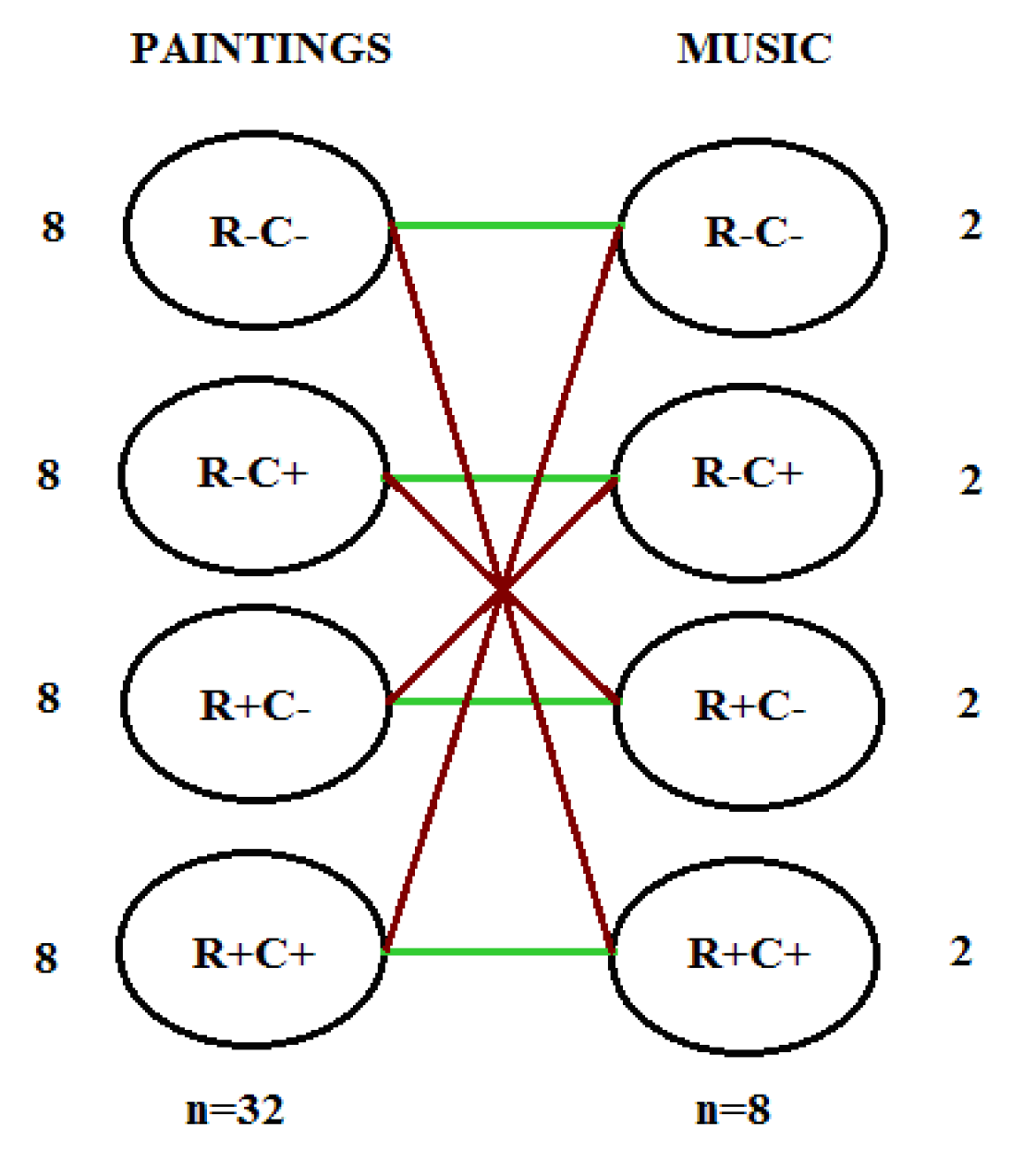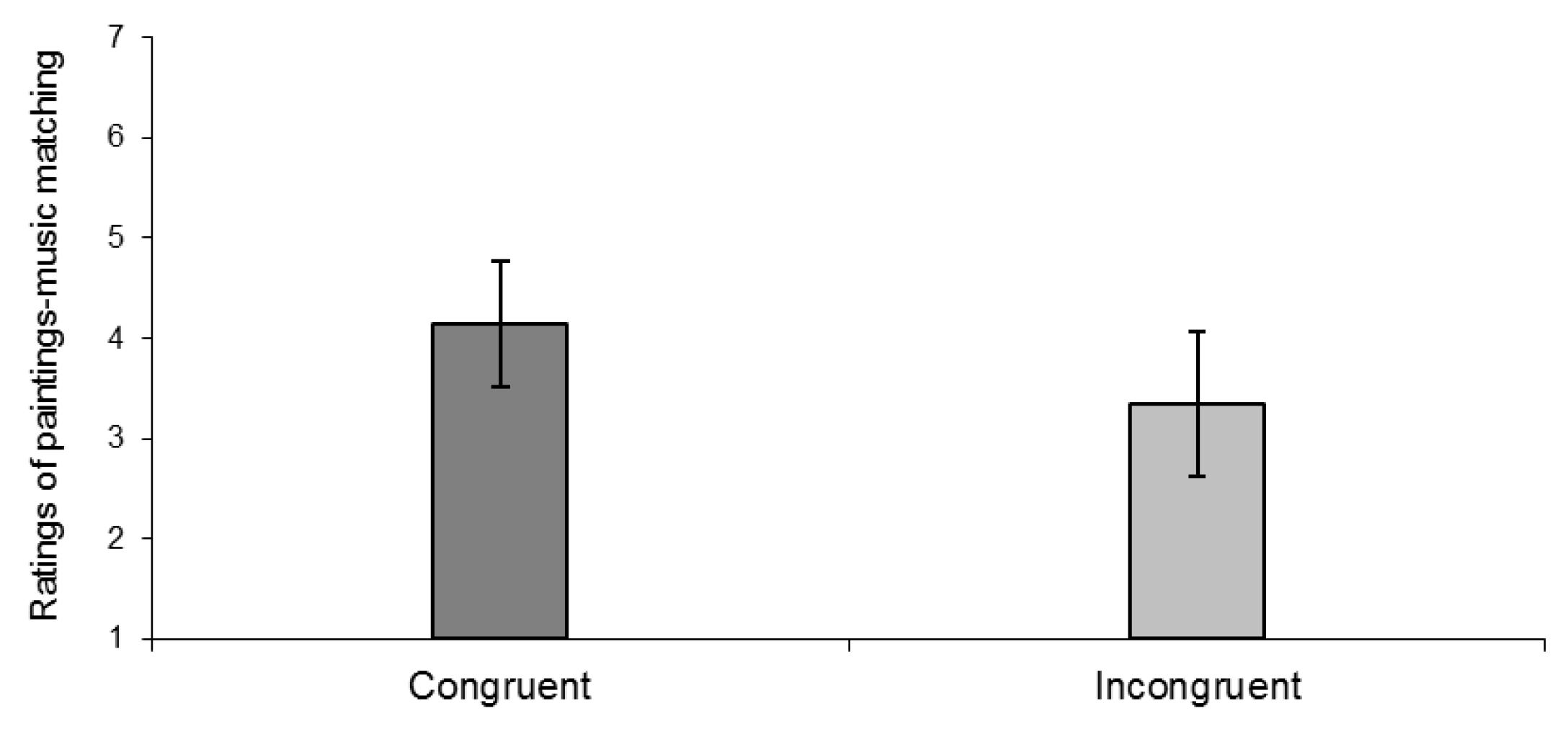The Perceptual and Aesthetic Aspects of the Music-Paintings Congruence
Abstract
1. Introduction
2. Preliminary Study
2.1. Materials and Methods
2.1.1. Participants
2.1.2. Stimuli
2.1.3. Procedure
2.2. Results
3. Main Experiment
3.1. Materials and Methods
3.1.1. Participants
3.1.2. Stimuli
3.1.3. Procedure
3.1.4. Design
- Congruence (C/I conditions);
- Congruence/silence (C/Sc; Sc denotes the paintings that were seen in both C and S conditions);
- Incongruence/silence (I/Si; Si denotes the half of paintings which were seen in both I and S conditions).
- Ratings of paintings liking.
- Ratings of paintings-music matching.
3.2. Results
3.2.1. Ratings of Paintings-Music Matching: Is the Congruence Defined by Regularity and Complexity between Music and Paintings Perceivable?
3.2.2. The Aesthetic Effect of Congruence: Is the Liking of the Paintings Higher in Congruent Conditions Compared to Incongruent Conditions?
3.3.3. The Aesthetic Effect of Music Presence: Is the Liking of the Paintings Higher When They Were Followed by Music Background Compared to Silence Conditions?
4. Discussion
Author Contributions
Funding
Conflicts of Interest
Appendix A. Paintings
| R−C− |
| Henri Michaux—Untitled |
| Kazimir Malevich—Suprematist Painting (with Black Trapezium and Red Square), 1915 |
| Linda Vachon—Untitled |
| Paul Klee—Fuge in Rot, 1921 |
| Richard Diabenkorn—Untitled, 1952 |
| Robert Motherwell—Dance I, 1978 |
| Robert Motherwell—Untitled, 1981 |
| Sam Francis—Untitled, 1964 |
| R−C+ |
| Alan Crockett—Cross Talk, 2017 |
| Jackson Pollock—The She Wolf, 1943 |
| Jackson Pollock—Composition |
| Maarten Jansen—Abstract Aberration, 2009 |
| Vojkan Djurdjevic—Bombers, 2013 |
| Wassily Kandinsky—Composition VII, 1913 |
| Wassily Kandinsky—Untitled, 1916 |
| Wassily Kandinsky—In Blue, 1925 |
| R+C− |
| Clare Rojas—Untitled, 2013 |
| Kazimir Malevich—Black Square, 1915 |
| Kenneth Noland—Days and Nights, 2008 |
| Louis Reith—Untitled |
| Mark Rothko—Black, Red and Black, 1968 |
| Piet Mondrian—Composition with red, blue and yellow, 1929 |
| Sonia Delaunay—Composition, 1934 |
| Zanis Waldheims—Untitled |
| R+C+ |
| Clayton Kashuba—Clashing, 2009 |
| Ella Prakash—Untitled |
| Frantisek Kupka—The shape of the blue (Tvar Modre), 1913 |
| George Sanen—Conversation with Jackson Pollock No. 42, 2015 |
| Kordula Cagemann—Untitled |
| Matt W. Moore—Untitled Spraypaint (Exhibition Gravity, Paris, 2012) |
| Piet Mondrian—Composition in Blue, Gray and Pink, 1913. |
| Wassily Kandinsky—Reciprocal Accords, 1942 |
Appendix B. Musical compositions
| R−C− |
| Charlie Parker and Miles Davis—Night in Tunisia, 00:52–01:22 |
| John Coltrane—Equinox, 02:30–03:00 |
| R−C+ |
| Charles Mingus—Boogie Stop Shuffle, 02:17–02:25, 03:21–03:43 |
| Weather Report—Havona, 04:09–04:39 |
| R+C− |
| Miles Davies—Blue in green, 03:00–03:30 |
| Yusef Lateef—Love theme from Spartacus, 02:16–02:46 |
| R+C+ |
| New York Ska Jazz Ensemble—Professor Bebop, 00:16–00:46 |
| New York Ska Jazz Ensemble—Take Five, 00:12–00:42 |
References
- Hinton, L.; Nichols, J.; Ohala, J.J. Sound Symbolism; Cambridge University Press: Berkley, MI, USA, 2006. [Google Scholar]
- Janković, D.; Marković, S. Phonetic-iconic congruency: Takete-Maluma phenomenon. In Proceedings of the Perception (Supplement), 23th ECVP, Groningen, The Netherlands, 27–31 August 2000; p. 77. [Google Scholar]
- Nuckolls, J. The case for sound symbolism. Annu. Rev. Anthropol. 2003, 28, 225–252. [Google Scholar] [CrossRef]
- Spence, C. Crossmodal Correspondences: A tutorial review. Atten. Percept. Psychophysis 2011, 73, 971–995. [Google Scholar] [CrossRef] [PubMed]
- Sapir, E. A study in phonetic symbolism. J. Exp. Psychol. 1929, 12, 225. [Google Scholar] [CrossRef]
- Gombrich, E.H. The mask and the face: The perception of physiognomic likeness in life and in art. In Art, Perception and Reality; Gombrich, E.C., Hochberg, J., Black, M., Eds.; The John and Hopkins University Press: Baltimore, MD, USA; London, UK, 1972; pp. 2–46. [Google Scholar]
- Köhler, W. Zum Problem der Regulation (On the problem of regulation). In The Selected Papers of Wolfgang Köhler; Henle, M., Ed.; Liveright: New York, NY, USA, 1971; pp. 305–326. [Google Scholar]
- Köhler, W. Gestalt Psychology; Liveright: New York, NY, USA, 1947. [Google Scholar]
- Ramachandran, V.C.; Hubbard, E.M. Synaesthesia: A window into perception, thought and language. J. Conscious. Stud. 2001, 8, 3–34. [Google Scholar]
- Lindborg, P.; Friberg, K.A. Colour association with music is mediated by emotion: Evidence from an experiment using a CIE Lab interface and interviews. PLoS ONE 2015, 10, e0144013. [Google Scholar] [CrossRef] [PubMed]
- Palmer, E.S.; Schloss, B.K.; Xu, Z.; Prado-Leon, R.L. Music-color associations are mediated by emotion. Proc. Natl. Acad. Sci. USA 2012, 110, 8836–8841. [Google Scholar] [CrossRef] [PubMed]
- Limbert, W.M.; Polzella, D.J. Effects of music on the perception of paintings. Empir. Stud. Arts 1998, 16, 33–39. [Google Scholar] [CrossRef]
- Siefkes, M. An experimental approach to multimodality: How musical and architectural styles interact in aesthetic perception. In Building Bridges for Multimodal Research: International Perspectives on Theories and Practices of Multimodal Analysis; Wildfeuer, J., Ed.; Peter Lang: New York, NY, USA, 2015; pp. 247–265. [Google Scholar]
- Koning, A.; van Lier, R. Effects of music on visual art: An eye movement study. In Proceedings of the Perception Supplement, 42th ECVP, Bremen, Germany, 25–29 August 2013; p. 103. [Google Scholar]
- Actis-Grosso, R.; Daneyko, O.; Cattaneo, Z.; Zavagno, D. What shall we listen to: Abstract or figurative music? In Proceedings of the Abstracts of the 4th VSAC, Barcelona, Spain, 26–28 August 2016; p. 17. [Google Scholar]
- Arnheim, R. Art and Visual Perception; University of California Press: Berkley, MI, USA; Los Angeles, CA, USA, 1969. [Google Scholar]
- Berlyne, D.E. Aesthetics and Psychobiology; Appleton Century-Crofts: New York, NY, USA, 1971. [Google Scholar]
- Berlyne, D.E. Studies in the New Experimental Aesthetics: Steps toward an Objective Psychology of Aesthetic Appreciation; Hemisphere: Washington, DC, USA, 1974. [Google Scholar]
- Birkhoff, G.D. Aesthetic Measure; Harvard University Press: Cambridge, MA, USA, 1932. [Google Scholar]
- Eysenck, H.J. The empirical determination of an aesthetic formula. Psychol. Rev. 1941, 48, 83–92. [Google Scholar] [CrossRef]
- Krupinski, E.; Locher, P. Skin conductance and aesthetic evaluative responses to nonrepresentational works of art varying in symmetry. Bull. Psychon. Soc. 1988, 26, 355–358. [Google Scholar] [CrossRef]
- Marković, S. Objective constraints on figural goodness. Psihologija 2002, 35, 245–260. [Google Scholar] [CrossRef]
- Marković, S.; Alfirević, Đ. Basic dimensions of experience of architectural objects’ expressiveness: Effect of expertise. Psihologija 2015, 48, 61–78. [Google Scholar] [CrossRef]
- Marković, S.; Gvozdenović, V. Symmetry, complexity and perceptual economy: Effects of minimum and maximum simplicity conditions. Vis. Cogn. 2001, 8, 305–327. [Google Scholar] [CrossRef]
- Nicki, R.M.; Moss, V. Preference for non-representational art as a function of various measures of complexity. Can. J. Exp. Psychol. 1975, 29, 237–249. [Google Scholar] [CrossRef]
- Ognjenović, P. Processing of aesthetic information. Empir. Stud. Arts 1991, 9, 1–9. [Google Scholar] [CrossRef]
- Osborne, J.W.; Farley, F.H. The relationship between aesthetic preference and visual complexity in abstract art. Psychon. Sci. 1970, 19, 69–70. [Google Scholar] [CrossRef]
- Stamps, A.E., III. Entropy, visual diversity and preference. J. Gen. Psychol. 2002, 129, 300–320. [Google Scholar] [CrossRef] [PubMed]
- Marković, S.; Radonjić, A. Implicit and explicit features of paintings. Spat. Vis. 2008, 21, 229–259. [Google Scholar] [CrossRef] [PubMed]
- Taylor, R. Pollock, Mondrian and the nature: Recent scientific investigations. Chaos Complex. Lett. 2004, 1, 29. [Google Scholar]
- Trkulja, M.; Janković, D. Towards three-dimensional model of affective experience of music. In Proceedings of the 12th ICMPC, Thessaloniki, Greece, 23–28 July 2012; pp. 1016–1017. [Google Scholar]


| Paintings | N | Regularity | Complexity | Pleasantness | Familiarity | ||||
|---|---|---|---|---|---|---|---|---|---|
| M | SD | M | SD | M | SD | M | SD | ||
| R+C+ | 8 | 5.41 | 0.39 | 4.76 | 0.26 | 4.29 | 0.26 | 3.58 | 0.36 |
| R+C− | 8 | 5.47 | 0.35 | 2.36 | 0.59 | 4.03 | 0.19 | 3.77 | 0.4 |
| R−C+ | 8 | 2.89 | 0.68 | 5.42 | 0.46 | 4.03 | 0.32 | 3.72 | 0.43 |
| R−C− | 8 | 3.43 | 0.21 | 3.39 | 0.26 | 4.09 | 0.36 | 3.39 | 0.38 |
| Music | N | Regularity | Complexity | Pleasantness | Familiarity | ||||
|---|---|---|---|---|---|---|---|---|---|
| M | SD | M | SD | M | SD | M | SD | ||
| R+C+ | 8 | 6.02 | 0.20 | 5.31 | 0.18 | 4.36 | 0.11 | 3.53 | 0.13 |
| R+C− | 8 | 5.92 | 0.20 | 2.6 | 0.02 | 4.17 | 0.02 | 3.4 | 0.75 |
| R−C+ | 8 | 4.34 | 0.08 | 3.38 | 0.13 | 4.17 | 0.11 | 3.28 | 0.09 |
| R−C− | 8 | 2.31 | 0.97 | 6.14 | 0.07 | 4.19 | 0.53 | 3.25 | 0.27 |
© 2019 by the authors. Licensee MDPI, Basel, Switzerland. This article is an open access article distributed under the terms and conditions of the Creative Commons Attribution (CC BY) license (http://creativecommons.org/licenses/by/4.0/).
Share and Cite
Rančić, K.; Marković, S. The Perceptual and Aesthetic Aspects of the Music-Paintings Congruence. Vision 2019, 3, 65. https://doi.org/10.3390/vision3040065
Rančić K, Marković S. The Perceptual and Aesthetic Aspects of the Music-Paintings Congruence. Vision. 2019; 3(4):65. https://doi.org/10.3390/vision3040065
Chicago/Turabian StyleRančić, Katarina, and Slobodan Marković. 2019. "The Perceptual and Aesthetic Aspects of the Music-Paintings Congruence" Vision 3, no. 4: 65. https://doi.org/10.3390/vision3040065
APA StyleRančić, K., & Marković, S. (2019). The Perceptual and Aesthetic Aspects of the Music-Paintings Congruence. Vision, 3(4), 65. https://doi.org/10.3390/vision3040065




